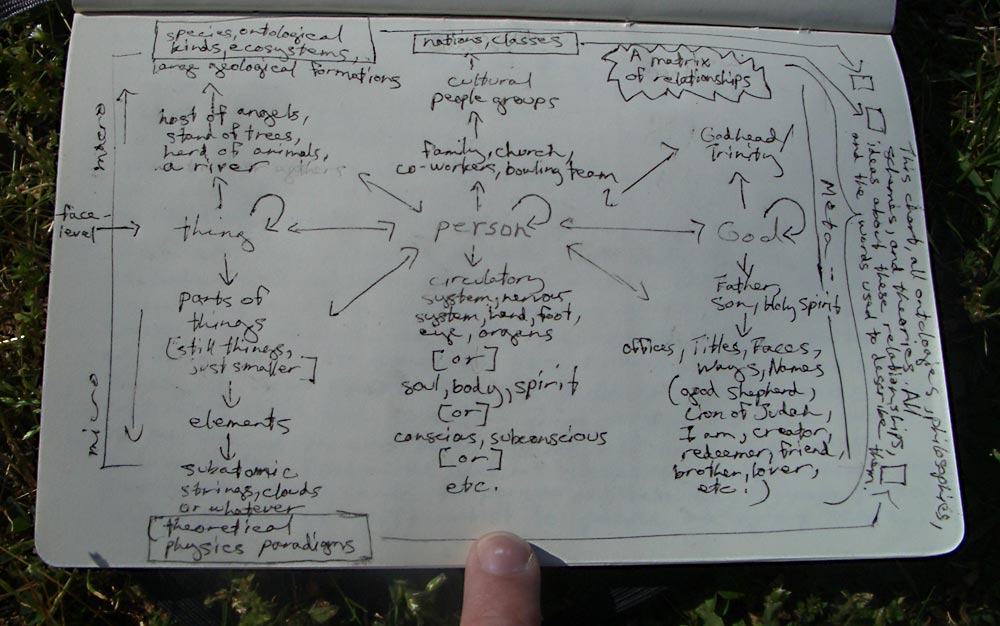
Notes about the chart:
1. Once all the stuff listed in the "meta-" section to the right of the chart enters into human culture, they become kinds of things that can then begin to interact with other things/people/God within the matrix itself.
2. Words must begin as meta/para-things and eventually be reified as ideas which are related to as things. Whereas art can begin by relating to things themselves (paint, light, sound, objects, etc.)
3a. With art, the assumed artist/creator has traditionally been a person at face-level (an individual person). The assumed audience has traditionally been people at a group (macro) scale. Duchamp and Cage used chance to shift the creator from person at face-level to something else like 'world force,' which could be thought of as thing on an uber-macro scale. Matt Mullican's performances under hypnosis shift the creator from person at face-level to person at micro level. Happenings shift the creator from person at face-level to people at a group scale. Much internet art and Yayoi Kusama's Firefiles on the Water installation shifts the audience from people at group scale to person at face-level (individual person).
3b. King David's psalms are a way to make art where the audience is God alone. St. Francis's sermon to the birds is a way to make art where the audience is things alone (although God in his omnipresence and omniscience is always also an audience of all art). Might a practice be devised where things are set to perpetually make art for God? Do things already make art for other things? Could I collaborate with things in their making art for each other? Is this what Andy Goldsworthy is doing (less the people-centric slide documentation and gallery commissions)? God has always made art for himself and things apart from people:
"Where were you when I laid the earth's foundation?
Tell me, if you understand.
Who marked off its dimensions? Surely you know!
Who stretched a measuring line across it?
On what were its footings set,
or who laid its cornerstone-
while the morning stars sang together
and all the angels shouted for joy?"
(Job 38:4-7)
4. Art following Deleuze (Stelarc, any art about networks) qeustions the dividing lines of this matrix, seeking to reconstitute it as more fluid and less granular.
5. Yet the heroine in C.S. Lewis's Till We Have Faces asks, "How can the Gods meet us face to face till we have faces?"
6. "Person" at face level can be further divided into "I/me" and "you." Every individual person is their own "I/me," to whom every other individual person is "you." "I" can begin to explore how "I" relate to myself/you/y'all/things/God; but "I" have a harder time exploring how "you" relate to yourself/me/y'all/things/God.
7. I am primarily interested in exploring the possible relationships afforded within this matrix (represented by the various arrows) in a qualitative way. [Note: God also relates directly to things and things directly to God, I just didn't draw those arrows in the chart.] I am curious what might constitute a "face-level" of things. I am interested in exploring what constitutes the "face-level" of a person only insofar as this understanding bears on the way in which a person might relate to (inter-'face' with) things/people/God. Regarding the "face-level" of God, I am reminded of Henri Nouwen's counfounding insight that we see in Jesus "the lovely human face of God." The most important relationship (to me) is between person at face-level and Jesus (the God/man) at face-level, because this relationship opens up onto God at all levels, and refracts back into all other relationships between people and things.
8. As an artist, I can't force relationships to happen, but I can create environments in which they might more readily occur, and I can attempt introductions. This suggests a practice of artist as host.
9. The meta/para semiotic aspects of this matrix have assumed an inordinate importance in the way we think about this relationship matrix and the world. I can use my art to create situations that foreground the impotence and inapplicability of words to get at the face-level of things/people/God and the relationships they have with themselves and each other. By publicly humiliating language I can open the door to other ways of understanding these relationships. More importantly, I can open the door to other ways of having these relationships.